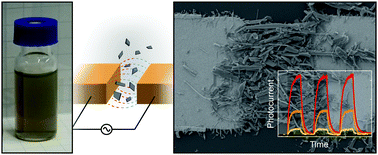当前位置:
X-MOL 学术
›
Chem. Commun.
›
论文详情
Our official English website, www.x-mol.net, welcomes your feedback! (Note: you will need to create a separate account there.)
Dielectrophoretic assembly of liquid-phase-exfoliated TiS3 nanoribbons for photodetecting applications
Chemical Communications ( IF 4.9 ) Pub Date : 2017-05-15 00:00:00 , DOI: 10.1039/c7cc01845b R. Frisenda 1, 2, 3, 4 , E. Giovanelli 1, 2, 3, 4 , P. Mishra 1, 2, 3, 4 , P. Gant 1, 2, 3, 4 , E. Flores 4, 5, 6, 7, 8 , C. Sánchez 4, 5, 6, 7, 8 , J. R. Ares 4, 5, 6, 7, 8 , D. Perez de Lara 1, 2, 3, 4 , I. J. Ferrer 4, 5, 6, 7, 8 , E. M. Pérez 1, 2, 3, 4 , A. Castellanos-Gomez 1, 2, 3, 4
Chemical Communications ( IF 4.9 ) Pub Date : 2017-05-15 00:00:00 , DOI: 10.1039/c7cc01845b R. Frisenda 1, 2, 3, 4 , E. Giovanelli 1, 2, 3, 4 , P. Mishra 1, 2, 3, 4 , P. Gant 1, 2, 3, 4 , E. Flores 4, 5, 6, 7, 8 , C. Sánchez 4, 5, 6, 7, 8 , J. R. Ares 4, 5, 6, 7, 8 , D. Perez de Lara 1, 2, 3, 4 , I. J. Ferrer 4, 5, 6, 7, 8 , E. M. Pérez 1, 2, 3, 4 , A. Castellanos-Gomez 1, 2, 3, 4
Affiliation

|
Liquid-phase exfoliation is a technique capable of producing large quantities of two-dimensional materials in suspension. Despite many efforts in the optimization of the exfoliation process itself, not much has been done towards the integration of liquid-phase-exfoliated materials in working solid-state devices. In this article, we use dielectrophoresis to direct the assembly of liquid-phase-exfoliated TiS3 nanoribbons between two gold electrodes to produce photodetectors working in the visible region. Through electrical and optical measurements we characterize the responsivity of the device and we find values as large as 3.8 mA W−1, which are more than one order of magnitude higher compared to state-of-the-art devices based on liquid-phase-exfoliated two-dimensional materials assembled by drop-casting or ink-jet methods.
中文翻译:

用于光电检测的液相剥离的TiS 3纳米带的介电泳组装
液相剥离是一种能够在悬浮液中产生大量二维材料的技术。尽管在剥离工艺本身的优化方面做出了许多努力,但是在将液相剥离材料集成到工作的固态设备中方面所做的工作还很少。在本文中,我们使用介电泳法指导液相剥离的TiS 3纳米带在两个金电极之间的组装,以产生在可见光区域工作的光电探测器。通过电学和光学测量,我们表征了设备的响应度,发现值高达3.8 mA W -1与通过滴铸或喷墨方法组装的基于液相剥离二维材料的最新设备相比,该设备要高出一个数量级。
更新日期:2017-05-24
中文翻译:

用于光电检测的液相剥离的TiS 3纳米带的介电泳组装
液相剥离是一种能够在悬浮液中产生大量二维材料的技术。尽管在剥离工艺本身的优化方面做出了许多努力,但是在将液相剥离材料集成到工作的固态设备中方面所做的工作还很少。在本文中,我们使用介电泳法指导液相剥离的TiS 3纳米带在两个金电极之间的组装,以产生在可见光区域工作的光电探测器。通过电学和光学测量,我们表征了设备的响应度,发现值高达3.8 mA W -1与通过滴铸或喷墨方法组装的基于液相剥离二维材料的最新设备相比,该设备要高出一个数量级。



























 京公网安备 11010802027423号
京公网安备 11010802027423号